Contemporary Accounting Theory: Analysis of Framework Concepts
VerifiedAdded on 2023/03/31
|20
|4261
|115
Report
AI Summary
This report provides a comprehensive analysis of the conceptual framework of contemporary accounting, examining its historical development and application within international accounting standards. The report is divided into two main sections. The first section focuses on the theoretical framework, evaluating its strengths, weaknesses, and addressing concerns from both accounting professionals and academics. The second section presents a comparative analysis of financial reports from Afterpay Touch Company and Reunert Company, highlighting the application of the framework and drawing upon existing literature. The report delves into key accounting terms, the integrated and non-integrated systems, and the model of sustainable accounting, using company annual reports to analyze the treatment of assets, liabilities, and revenues. The report also provides a review of the conceptual framework's benefits and limitations, including its relevance to various stakeholders and its role in capital acquisition and resource allocation. The report also examines the compliance of Afterpay Touch with the requirements of the framework.
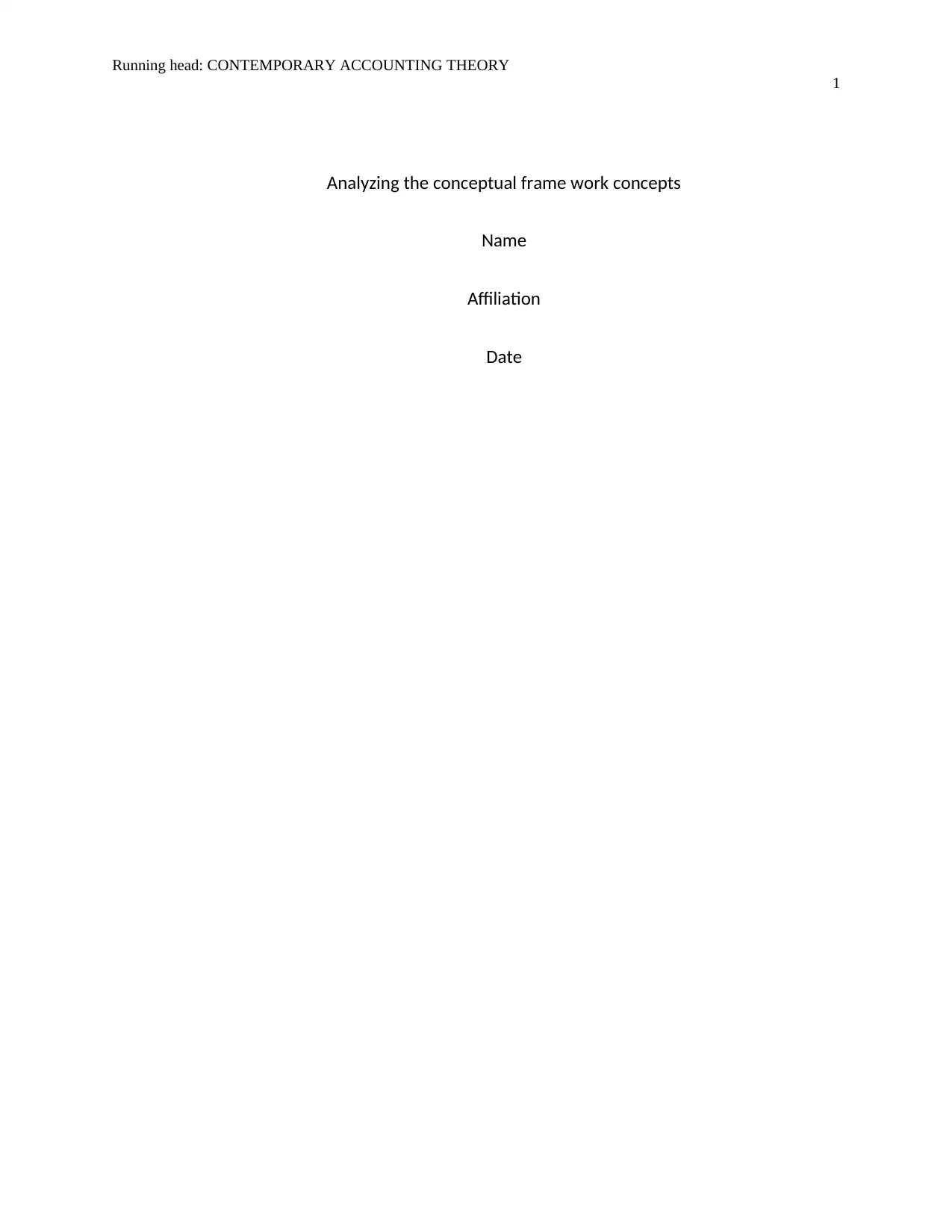
Running head: CONTEMPORARY ACCOUNTING THEORY
1
Analyzing the conceptual frame work concepts
Name
Affiliation
Date
1
Analyzing the conceptual frame work concepts
Name
Affiliation
Date
Paraphrase This Document
Need a fresh take? Get an instant paraphrase of this document with our AI Paraphraser
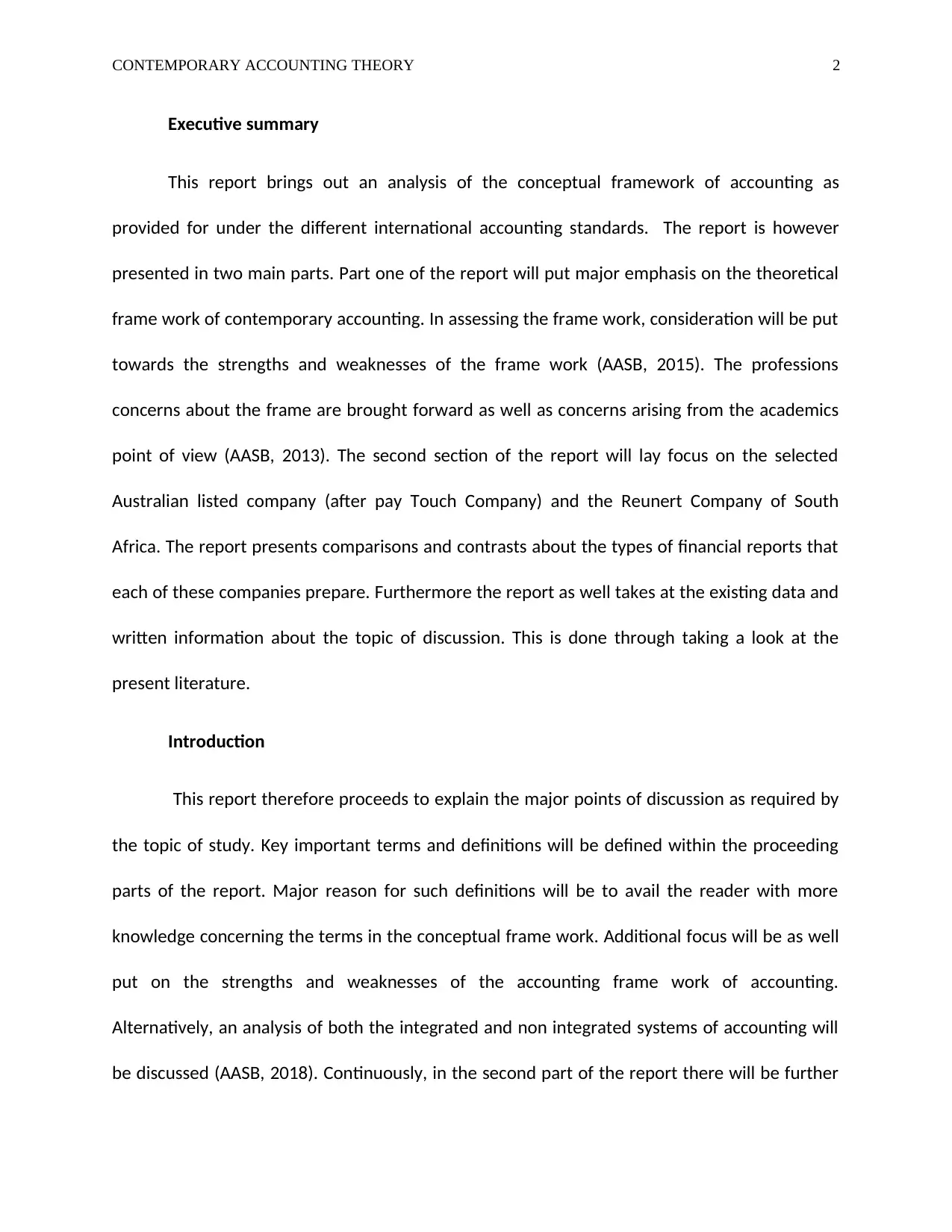
CONTEMPORARY ACCOUNTING THEORY 2
Executive summary
This report brings out an analysis of the conceptual framework of accounting as
provided for under the different international accounting standards. The report is however
presented in two main parts. Part one of the report will put major emphasis on the theoretical
frame work of contemporary accounting. In assessing the frame work, consideration will be put
towards the strengths and weaknesses of the frame work (AASB, 2015). The professions
concerns about the frame are brought forward as well as concerns arising from the academics
point of view (AASB, 2013). The second section of the report will lay focus on the selected
Australian listed company (after pay Touch Company) and the Reunert Company of South
Africa. The report presents comparisons and contrasts about the types of financial reports that
each of these companies prepare. Furthermore the report as well takes at the existing data and
written information about the topic of discussion. This is done through taking a look at the
present literature.
Introduction
This report therefore proceeds to explain the major points of discussion as required by
the topic of study. Key important terms and definitions will be defined within the proceeding
parts of the report. Major reason for such definitions will be to avail the reader with more
knowledge concerning the terms in the conceptual frame work. Additional focus will be as well
put on the strengths and weaknesses of the accounting frame work of accounting.
Alternatively, an analysis of both the integrated and non integrated systems of accounting will
be discussed (AASB, 2018). Continuously, in the second part of the report there will be further
Executive summary
This report brings out an analysis of the conceptual framework of accounting as
provided for under the different international accounting standards. The report is however
presented in two main parts. Part one of the report will put major emphasis on the theoretical
frame work of contemporary accounting. In assessing the frame work, consideration will be put
towards the strengths and weaknesses of the frame work (AASB, 2015). The professions
concerns about the frame are brought forward as well as concerns arising from the academics
point of view (AASB, 2013). The second section of the report will lay focus on the selected
Australian listed company (after pay Touch Company) and the Reunert Company of South
Africa. The report presents comparisons and contrasts about the types of financial reports that
each of these companies prepare. Furthermore the report as well takes at the existing data and
written information about the topic of discussion. This is done through taking a look at the
present literature.
Introduction
This report therefore proceeds to explain the major points of discussion as required by
the topic of study. Key important terms and definitions will be defined within the proceeding
parts of the report. Major reason for such definitions will be to avail the reader with more
knowledge concerning the terms in the conceptual frame work. Additional focus will be as well
put on the strengths and weaknesses of the accounting frame work of accounting.
Alternatively, an analysis of both the integrated and non integrated systems of accounting will
be discussed (AASB, 2018). Continuously, in the second part of the report there will be further
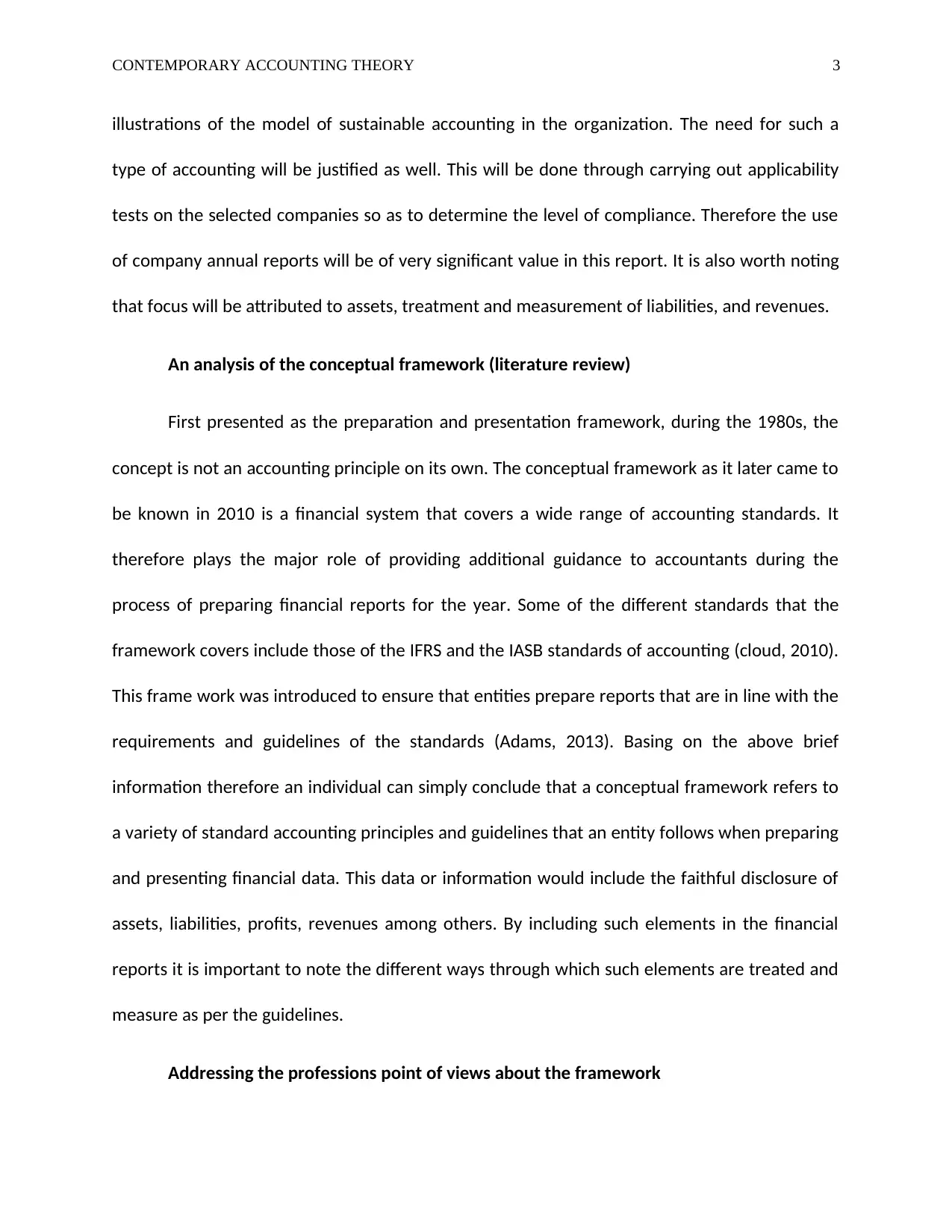
CONTEMPORARY ACCOUNTING THEORY 3
illustrations of the model of sustainable accounting in the organization. The need for such a
type of accounting will be justified as well. This will be done through carrying out applicability
tests on the selected companies so as to determine the level of compliance. Therefore the use
of company annual reports will be of very significant value in this report. It is also worth noting
that focus will be attributed to assets, treatment and measurement of liabilities, and revenues.
An analysis of the conceptual framework (literature review)
First presented as the preparation and presentation framework, during the 1980s, the
concept is not an accounting principle on its own. The conceptual framework as it later came to
be known in 2010 is a financial system that covers a wide range of accounting standards. It
therefore plays the major role of providing additional guidance to accountants during the
process of preparing financial reports for the year. Some of the different standards that the
framework covers include those of the IFRS and the IASB standards of accounting (cloud, 2010).
This frame work was introduced to ensure that entities prepare reports that are in line with the
requirements and guidelines of the standards (Adams, 2013). Basing on the above brief
information therefore an individual can simply conclude that a conceptual framework refers to
a variety of standard accounting principles and guidelines that an entity follows when preparing
and presenting financial data. This data or information would include the faithful disclosure of
assets, liabilities, profits, revenues among others. By including such elements in the financial
reports it is important to note the different ways through which such elements are treated and
measure as per the guidelines.
Addressing the professions point of views about the framework
illustrations of the model of sustainable accounting in the organization. The need for such a
type of accounting will be justified as well. This will be done through carrying out applicability
tests on the selected companies so as to determine the level of compliance. Therefore the use
of company annual reports will be of very significant value in this report. It is also worth noting
that focus will be attributed to assets, treatment and measurement of liabilities, and revenues.
An analysis of the conceptual framework (literature review)
First presented as the preparation and presentation framework, during the 1980s, the
concept is not an accounting principle on its own. The conceptual framework as it later came to
be known in 2010 is a financial system that covers a wide range of accounting standards. It
therefore plays the major role of providing additional guidance to accountants during the
process of preparing financial reports for the year. Some of the different standards that the
framework covers include those of the IFRS and the IASB standards of accounting (cloud, 2010).
This frame work was introduced to ensure that entities prepare reports that are in line with the
requirements and guidelines of the standards (Adams, 2013). Basing on the above brief
information therefore an individual can simply conclude that a conceptual framework refers to
a variety of standard accounting principles and guidelines that an entity follows when preparing
and presenting financial data. This data or information would include the faithful disclosure of
assets, liabilities, profits, revenues among others. By including such elements in the financial
reports it is important to note the different ways through which such elements are treated and
measure as per the guidelines.
Addressing the professions point of views about the framework
⊘ This is a preview!⊘
Do you want full access?
Subscribe today to unlock all pages.

Trusted by 1+ million students worldwide
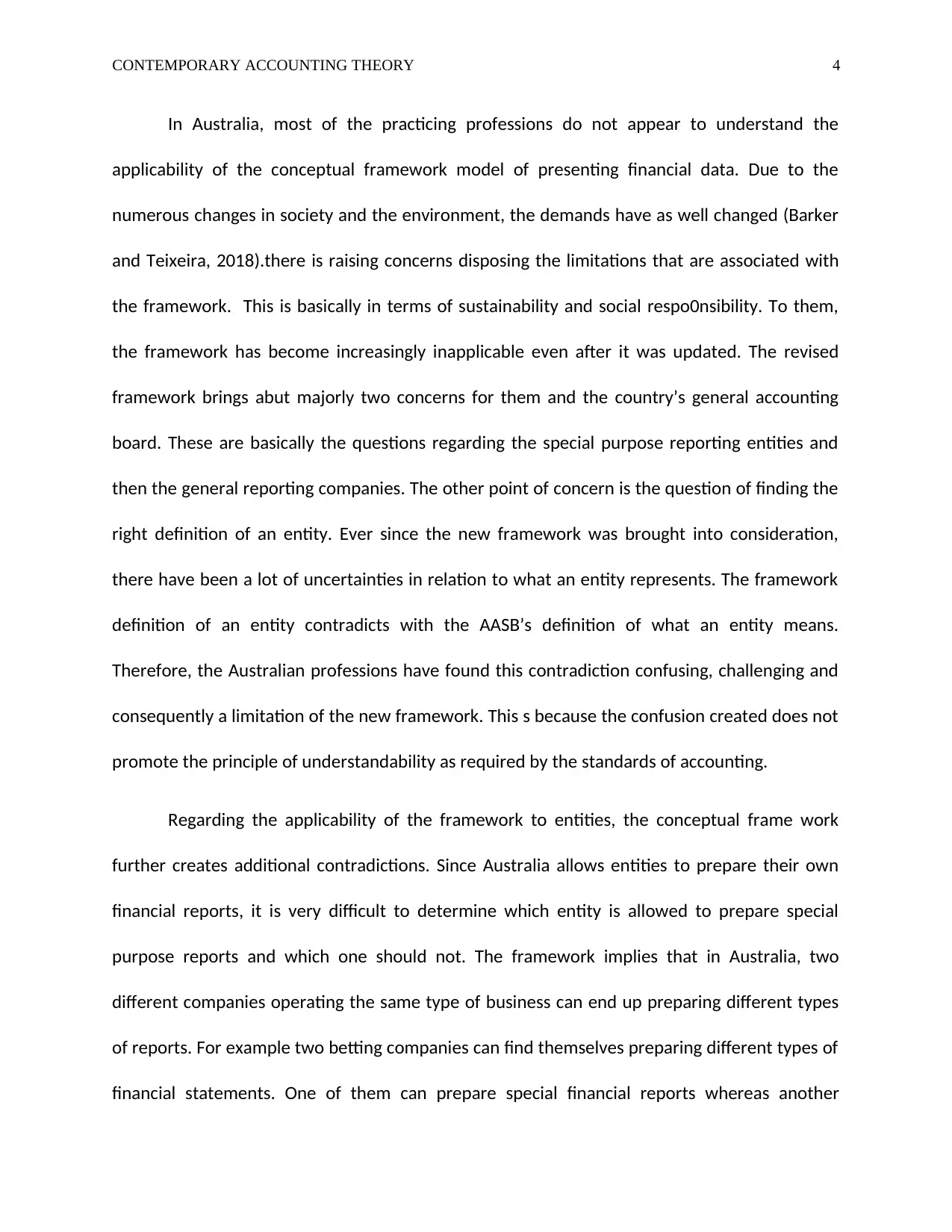
CONTEMPORARY ACCOUNTING THEORY 4
In Australia, most of the practicing professions do not appear to understand the
applicability of the conceptual framework model of presenting financial data. Due to the
numerous changes in society and the environment, the demands have as well changed (Barker
and Teixeira, 2018).there is raising concerns disposing the limitations that are associated with
the framework. This is basically in terms of sustainability and social respo0nsibility. To them,
the framework has become increasingly inapplicable even after it was updated. The revised
framework brings abut majorly two concerns for them and the country’s general accounting
board. These are basically the questions regarding the special purpose reporting entities and
then the general reporting companies. The other point of concern is the question of finding the
right definition of an entity. Ever since the new framework was brought into consideration,
there have been a lot of uncertainties in relation to what an entity represents. The framework
definition of an entity contradicts with the AASB’s definition of what an entity means.
Therefore, the Australian professions have found this contradiction confusing, challenging and
consequently a limitation of the new framework. This s because the confusion created does not
promote the principle of understandability as required by the standards of accounting.
Regarding the applicability of the framework to entities, the conceptual frame work
further creates additional contradictions. Since Australia allows entities to prepare their own
financial reports, it is very difficult to determine which entity is allowed to prepare special
purpose reports and which one should not. The framework implies that in Australia, two
different companies operating the same type of business can end up preparing different types
of reports. For example two betting companies can find themselves preparing different types of
financial statements. One of them can prepare special financial reports whereas another
In Australia, most of the practicing professions do not appear to understand the
applicability of the conceptual framework model of presenting financial data. Due to the
numerous changes in society and the environment, the demands have as well changed (Barker
and Teixeira, 2018).there is raising concerns disposing the limitations that are associated with
the framework. This is basically in terms of sustainability and social respo0nsibility. To them,
the framework has become increasingly inapplicable even after it was updated. The revised
framework brings abut majorly two concerns for them and the country’s general accounting
board. These are basically the questions regarding the special purpose reporting entities and
then the general reporting companies. The other point of concern is the question of finding the
right definition of an entity. Ever since the new framework was brought into consideration,
there have been a lot of uncertainties in relation to what an entity represents. The framework
definition of an entity contradicts with the AASB’s definition of what an entity means.
Therefore, the Australian professions have found this contradiction confusing, challenging and
consequently a limitation of the new framework. This s because the confusion created does not
promote the principle of understandability as required by the standards of accounting.
Regarding the applicability of the framework to entities, the conceptual frame work
further creates additional contradictions. Since Australia allows entities to prepare their own
financial reports, it is very difficult to determine which entity is allowed to prepare special
purpose reports and which one should not. The framework implies that in Australia, two
different companies operating the same type of business can end up preparing different types
of reports. For example two betting companies can find themselves preparing different types of
financial statements. One of them can prepare special financial reports whereas another
Paraphrase This Document
Need a fresh take? Get an instant paraphrase of this document with our AI Paraphraser
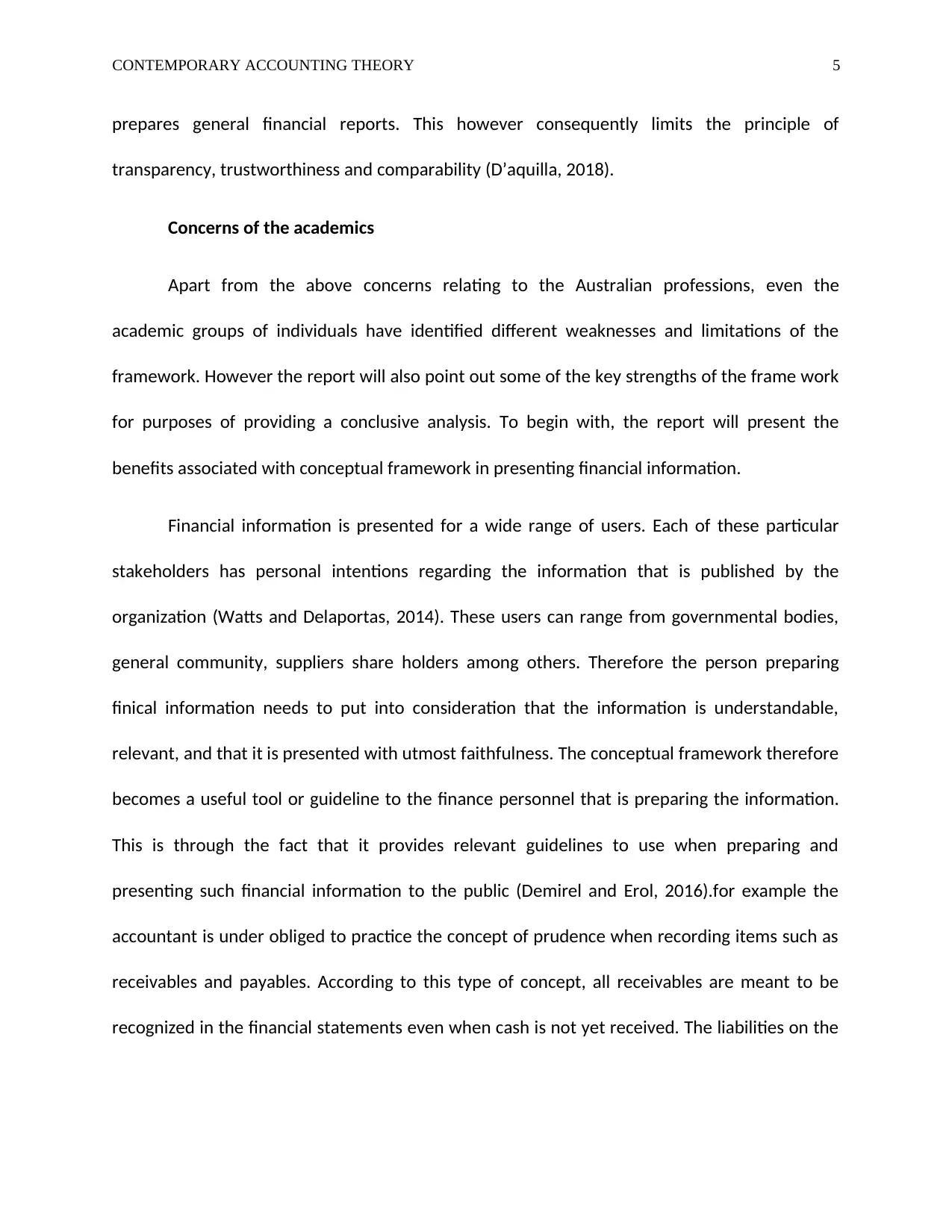
CONTEMPORARY ACCOUNTING THEORY 5
prepares general financial reports. This however consequently limits the principle of
transparency, trustworthiness and comparability (D’aquilla, 2018).
Concerns of the academics
Apart from the above concerns relating to the Australian professions, even the
academic groups of individuals have identified different weaknesses and limitations of the
framework. However the report will also point out some of the key strengths of the frame work
for purposes of providing a conclusive analysis. To begin with, the report will present the
benefits associated with conceptual framework in presenting financial information.
Financial information is presented for a wide range of users. Each of these particular
stakeholders has personal intentions regarding the information that is published by the
organization (Watts and Delaportas, 2014). These users can range from governmental bodies,
general community, suppliers share holders among others. Therefore the person preparing
finical information needs to put into consideration that the information is understandable,
relevant, and that it is presented with utmost faithfulness. The conceptual framework therefore
becomes a useful tool or guideline to the finance personnel that is preparing the information.
This is through the fact that it provides relevant guidelines to use when preparing and
presenting such financial information to the public (Demirel and Erol, 2016).for example the
accountant is under obliged to practice the concept of prudence when recording items such as
receivables and payables. According to this type of concept, all receivables are meant to be
recognized in the financial statements even when cash is not yet received. The liabilities on the
prepares general financial reports. This however consequently limits the principle of
transparency, trustworthiness and comparability (D’aquilla, 2018).
Concerns of the academics
Apart from the above concerns relating to the Australian professions, even the
academic groups of individuals have identified different weaknesses and limitations of the
framework. However the report will also point out some of the key strengths of the frame work
for purposes of providing a conclusive analysis. To begin with, the report will present the
benefits associated with conceptual framework in presenting financial information.
Financial information is presented for a wide range of users. Each of these particular
stakeholders has personal intentions regarding the information that is published by the
organization (Watts and Delaportas, 2014). These users can range from governmental bodies,
general community, suppliers share holders among others. Therefore the person preparing
finical information needs to put into consideration that the information is understandable,
relevant, and that it is presented with utmost faithfulness. The conceptual framework therefore
becomes a useful tool or guideline to the finance personnel that is preparing the information.
This is through the fact that it provides relevant guidelines to use when preparing and
presenting such financial information to the public (Demirel and Erol, 2016).for example the
accountant is under obliged to practice the concept of prudence when recording items such as
receivables and payables. According to this type of concept, all receivables are meant to be
recognized in the financial statements even when cash is not yet received. The liabilities on the
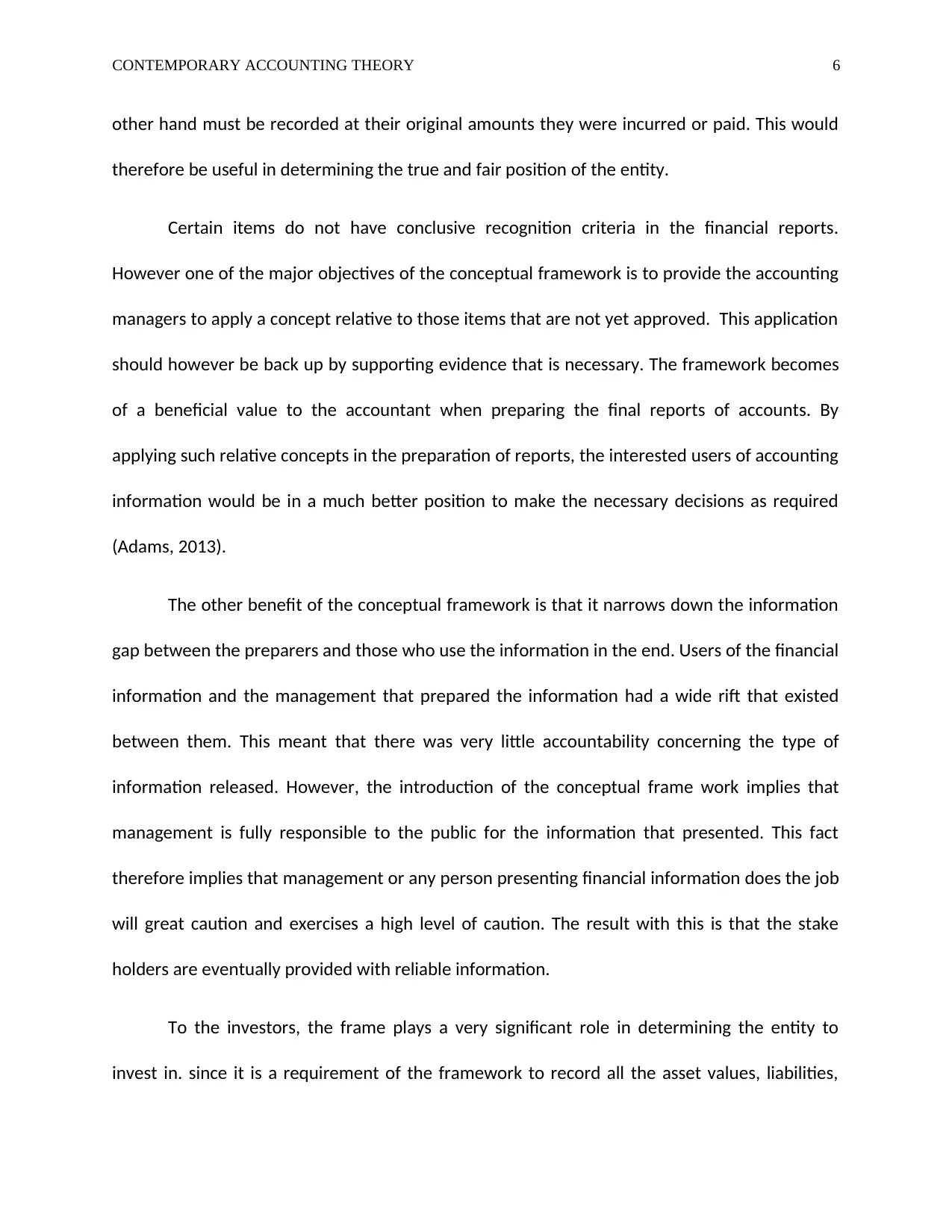
CONTEMPORARY ACCOUNTING THEORY 6
other hand must be recorded at their original amounts they were incurred or paid. This would
therefore be useful in determining the true and fair position of the entity.
Certain items do not have conclusive recognition criteria in the financial reports.
However one of the major objectives of the conceptual framework is to provide the accounting
managers to apply a concept relative to those items that are not yet approved. This application
should however be back up by supporting evidence that is necessary. The framework becomes
of a beneficial value to the accountant when preparing the final reports of accounts. By
applying such relative concepts in the preparation of reports, the interested users of accounting
information would be in a much better position to make the necessary decisions as required
(Adams, 2013).
The other benefit of the conceptual framework is that it narrows down the information
gap between the preparers and those who use the information in the end. Users of the financial
information and the management that prepared the information had a wide rift that existed
between them. This meant that there was very little accountability concerning the type of
information released. However, the introduction of the conceptual frame work implies that
management is fully responsible to the public for the information that presented. This fact
therefore implies that management or any person presenting financial information does the job
will great caution and exercises a high level of caution. The result with this is that the stake
holders are eventually provided with reliable information.
To the investors, the frame plays a very significant role in determining the entity to
invest in. since it is a requirement of the framework to record all the asset values, liabilities,
other hand must be recorded at their original amounts they were incurred or paid. This would
therefore be useful in determining the true and fair position of the entity.
Certain items do not have conclusive recognition criteria in the financial reports.
However one of the major objectives of the conceptual framework is to provide the accounting
managers to apply a concept relative to those items that are not yet approved. This application
should however be back up by supporting evidence that is necessary. The framework becomes
of a beneficial value to the accountant when preparing the final reports of accounts. By
applying such relative concepts in the preparation of reports, the interested users of accounting
information would be in a much better position to make the necessary decisions as required
(Adams, 2013).
The other benefit of the conceptual framework is that it narrows down the information
gap between the preparers and those who use the information in the end. Users of the financial
information and the management that prepared the information had a wide rift that existed
between them. This meant that there was very little accountability concerning the type of
information released. However, the introduction of the conceptual frame work implies that
management is fully responsible to the public for the information that presented. This fact
therefore implies that management or any person presenting financial information does the job
will great caution and exercises a high level of caution. The result with this is that the stake
holders are eventually provided with reliable information.
To the investors, the frame plays a very significant role in determining the entity to
invest in. since it is a requirement of the framework to record all the asset values, liabilities,
⊘ This is a preview!⊘
Do you want full access?
Subscribe today to unlock all pages.

Trusted by 1+ million students worldwide
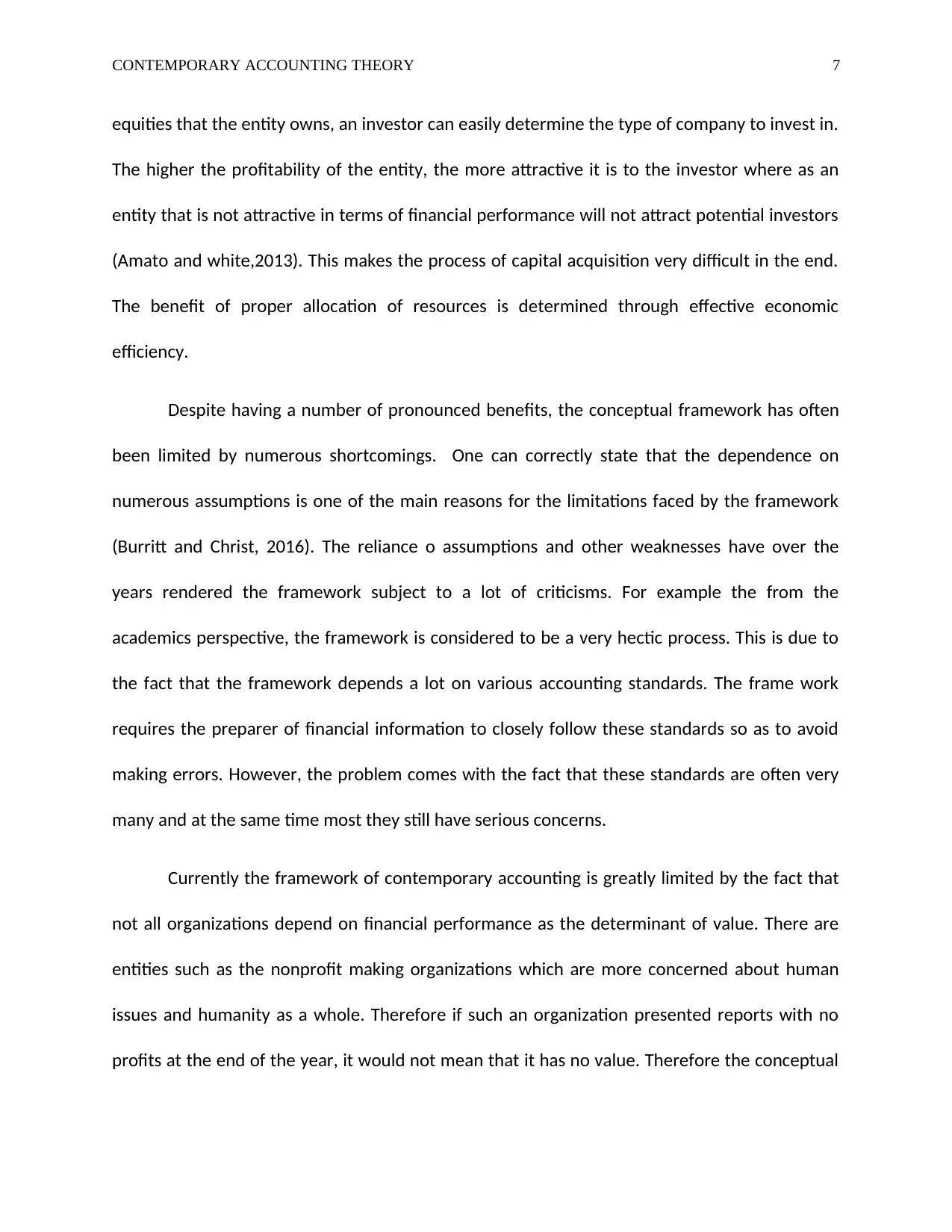
CONTEMPORARY ACCOUNTING THEORY 7
equities that the entity owns, an investor can easily determine the type of company to invest in.
The higher the profitability of the entity, the more attractive it is to the investor where as an
entity that is not attractive in terms of financial performance will not attract potential investors
(Amato and white,2013). This makes the process of capital acquisition very difficult in the end.
The benefit of proper allocation of resources is determined through effective economic
efficiency.
Despite having a number of pronounced benefits, the conceptual framework has often
been limited by numerous shortcomings. One can correctly state that the dependence on
numerous assumptions is one of the main reasons for the limitations faced by the framework
(Burritt and Christ, 2016). The reliance o assumptions and other weaknesses have over the
years rendered the framework subject to a lot of criticisms. For example the from the
academics perspective, the framework is considered to be a very hectic process. This is due to
the fact that the framework depends a lot on various accounting standards. The frame work
requires the preparer of financial information to closely follow these standards so as to avoid
making errors. However, the problem comes with the fact that these standards are often very
many and at the same time most they still have serious concerns.
Currently the framework of contemporary accounting is greatly limited by the fact that
not all organizations depend on financial performance as the determinant of value. There are
entities such as the nonprofit making organizations which are more concerned about human
issues and humanity as a whole. Therefore if such an organization presented reports with no
profits at the end of the year, it would not mean that it has no value. Therefore the conceptual
equities that the entity owns, an investor can easily determine the type of company to invest in.
The higher the profitability of the entity, the more attractive it is to the investor where as an
entity that is not attractive in terms of financial performance will not attract potential investors
(Amato and white,2013). This makes the process of capital acquisition very difficult in the end.
The benefit of proper allocation of resources is determined through effective economic
efficiency.
Despite having a number of pronounced benefits, the conceptual framework has often
been limited by numerous shortcomings. One can correctly state that the dependence on
numerous assumptions is one of the main reasons for the limitations faced by the framework
(Burritt and Christ, 2016). The reliance o assumptions and other weaknesses have over the
years rendered the framework subject to a lot of criticisms. For example the from the
academics perspective, the framework is considered to be a very hectic process. This is due to
the fact that the framework depends a lot on various accounting standards. The frame work
requires the preparer of financial information to closely follow these standards so as to avoid
making errors. However, the problem comes with the fact that these standards are often very
many and at the same time most they still have serious concerns.
Currently the framework of contemporary accounting is greatly limited by the fact that
not all organizations depend on financial performance as the determinant of value. There are
entities such as the nonprofit making organizations which are more concerned about human
issues and humanity as a whole. Therefore if such an organization presented reports with no
profits at the end of the year, it would not mean that it has no value. Therefore the conceptual
Paraphrase This Document
Need a fresh take? Get an instant paraphrase of this document with our AI Paraphraser
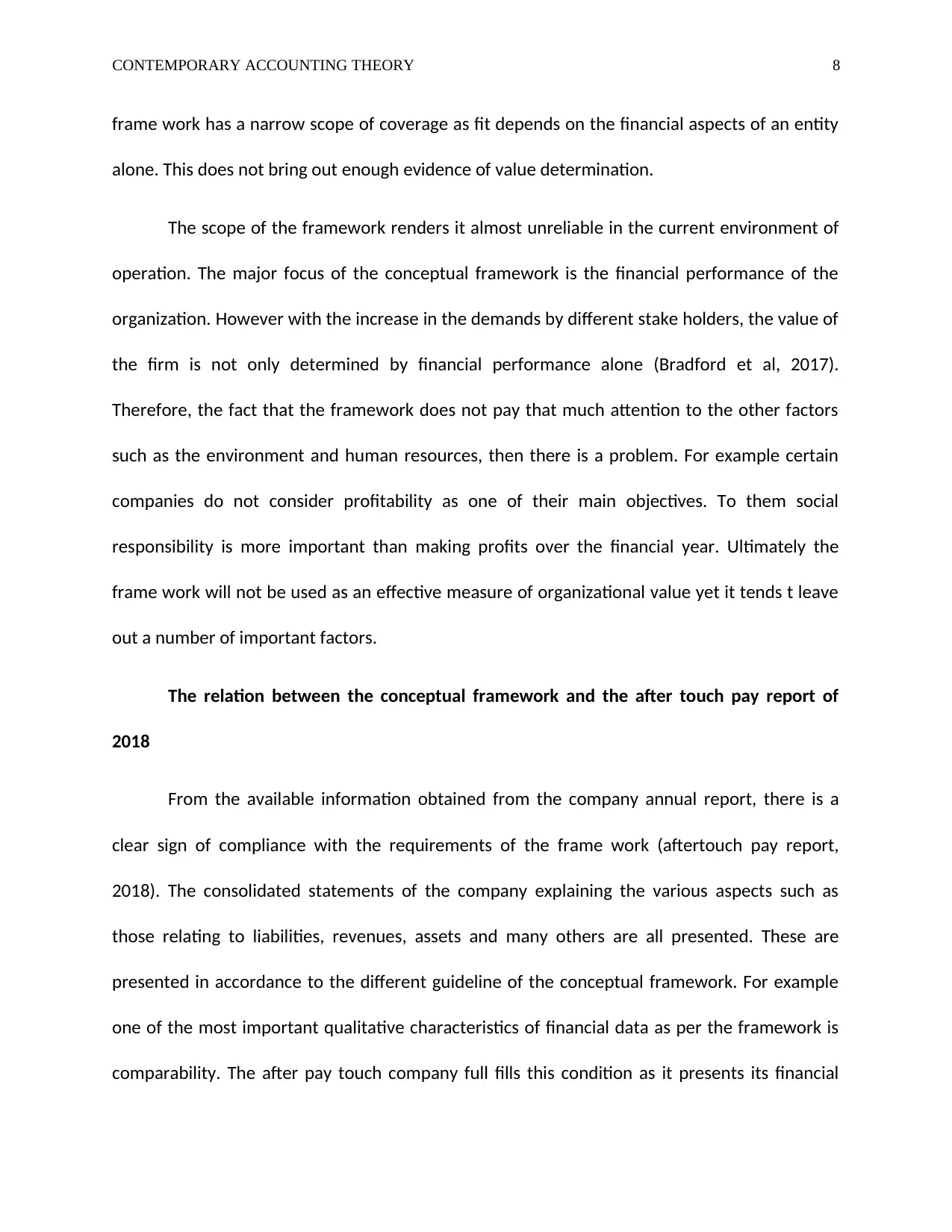
CONTEMPORARY ACCOUNTING THEORY 8
frame work has a narrow scope of coverage as fit depends on the financial aspects of an entity
alone. This does not bring out enough evidence of value determination.
The scope of the framework renders it almost unreliable in the current environment of
operation. The major focus of the conceptual framework is the financial performance of the
organization. However with the increase in the demands by different stake holders, the value of
the firm is not only determined by financial performance alone (Bradford et al, 2017).
Therefore, the fact that the framework does not pay that much attention to the other factors
such as the environment and human resources, then there is a problem. For example certain
companies do not consider profitability as one of their main objectives. To them social
responsibility is more important than making profits over the financial year. Ultimately the
frame work will not be used as an effective measure of organizational value yet it tends t leave
out a number of important factors.
The relation between the conceptual framework and the after touch pay report of
2018
From the available information obtained from the company annual report, there is a
clear sign of compliance with the requirements of the frame work (aftertouch pay report,
2018). The consolidated statements of the company explaining the various aspects such as
those relating to liabilities, revenues, assets and many others are all presented. These are
presented in accordance to the different guideline of the conceptual framework. For example
one of the most important qualitative characteristics of financial data as per the framework is
comparability. The after pay touch company full fills this condition as it presents its financial
frame work has a narrow scope of coverage as fit depends on the financial aspects of an entity
alone. This does not bring out enough evidence of value determination.
The scope of the framework renders it almost unreliable in the current environment of
operation. The major focus of the conceptual framework is the financial performance of the
organization. However with the increase in the demands by different stake holders, the value of
the firm is not only determined by financial performance alone (Bradford et al, 2017).
Therefore, the fact that the framework does not pay that much attention to the other factors
such as the environment and human resources, then there is a problem. For example certain
companies do not consider profitability as one of their main objectives. To them social
responsibility is more important than making profits over the financial year. Ultimately the
frame work will not be used as an effective measure of organizational value yet it tends t leave
out a number of important factors.
The relation between the conceptual framework and the after touch pay report of
2018
From the available information obtained from the company annual report, there is a
clear sign of compliance with the requirements of the frame work (aftertouch pay report,
2018). The consolidated statements of the company explaining the various aspects such as
those relating to liabilities, revenues, assets and many others are all presented. These are
presented in accordance to the different guideline of the conceptual framework. For example
one of the most important qualitative characteristics of financial data as per the framework is
comparability. The after pay touch company full fills this condition as it presents its financial
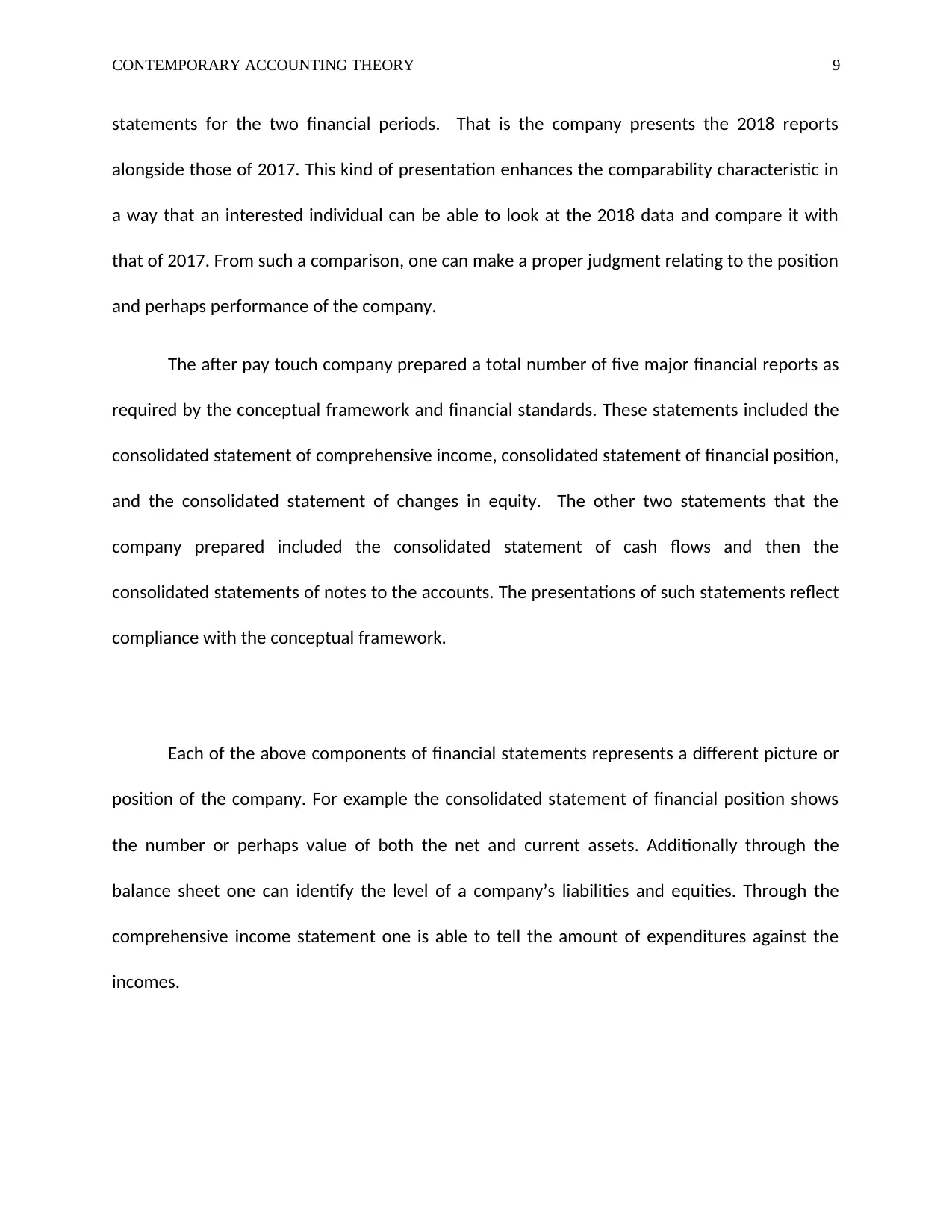
CONTEMPORARY ACCOUNTING THEORY 9
statements for the two financial periods. That is the company presents the 2018 reports
alongside those of 2017. This kind of presentation enhances the comparability characteristic in
a way that an interested individual can be able to look at the 2018 data and compare it with
that of 2017. From such a comparison, one can make a proper judgment relating to the position
and perhaps performance of the company.
The after pay touch company prepared a total number of five major financial reports as
required by the conceptual framework and financial standards. These statements included the
consolidated statement of comprehensive income, consolidated statement of financial position,
and the consolidated statement of changes in equity. The other two statements that the
company prepared included the consolidated statement of cash flows and then the
consolidated statements of notes to the accounts. The presentations of such statements reflect
compliance with the conceptual framework.
Each of the above components of financial statements represents a different picture or
position of the company. For example the consolidated statement of financial position shows
the number or perhaps value of both the net and current assets. Additionally through the
balance sheet one can identify the level of a company’s liabilities and equities. Through the
comprehensive income statement one is able to tell the amount of expenditures against the
incomes.
statements for the two financial periods. That is the company presents the 2018 reports
alongside those of 2017. This kind of presentation enhances the comparability characteristic in
a way that an interested individual can be able to look at the 2018 data and compare it with
that of 2017. From such a comparison, one can make a proper judgment relating to the position
and perhaps performance of the company.
The after pay touch company prepared a total number of five major financial reports as
required by the conceptual framework and financial standards. These statements included the
consolidated statement of comprehensive income, consolidated statement of financial position,
and the consolidated statement of changes in equity. The other two statements that the
company prepared included the consolidated statement of cash flows and then the
consolidated statements of notes to the accounts. The presentations of such statements reflect
compliance with the conceptual framework.
Each of the above components of financial statements represents a different picture or
position of the company. For example the consolidated statement of financial position shows
the number or perhaps value of both the net and current assets. Additionally through the
balance sheet one can identify the level of a company’s liabilities and equities. Through the
comprehensive income statement one is able to tell the amount of expenditures against the
incomes.
⊘ This is a preview!⊘
Do you want full access?
Subscribe today to unlock all pages.

Trusted by 1+ million students worldwide
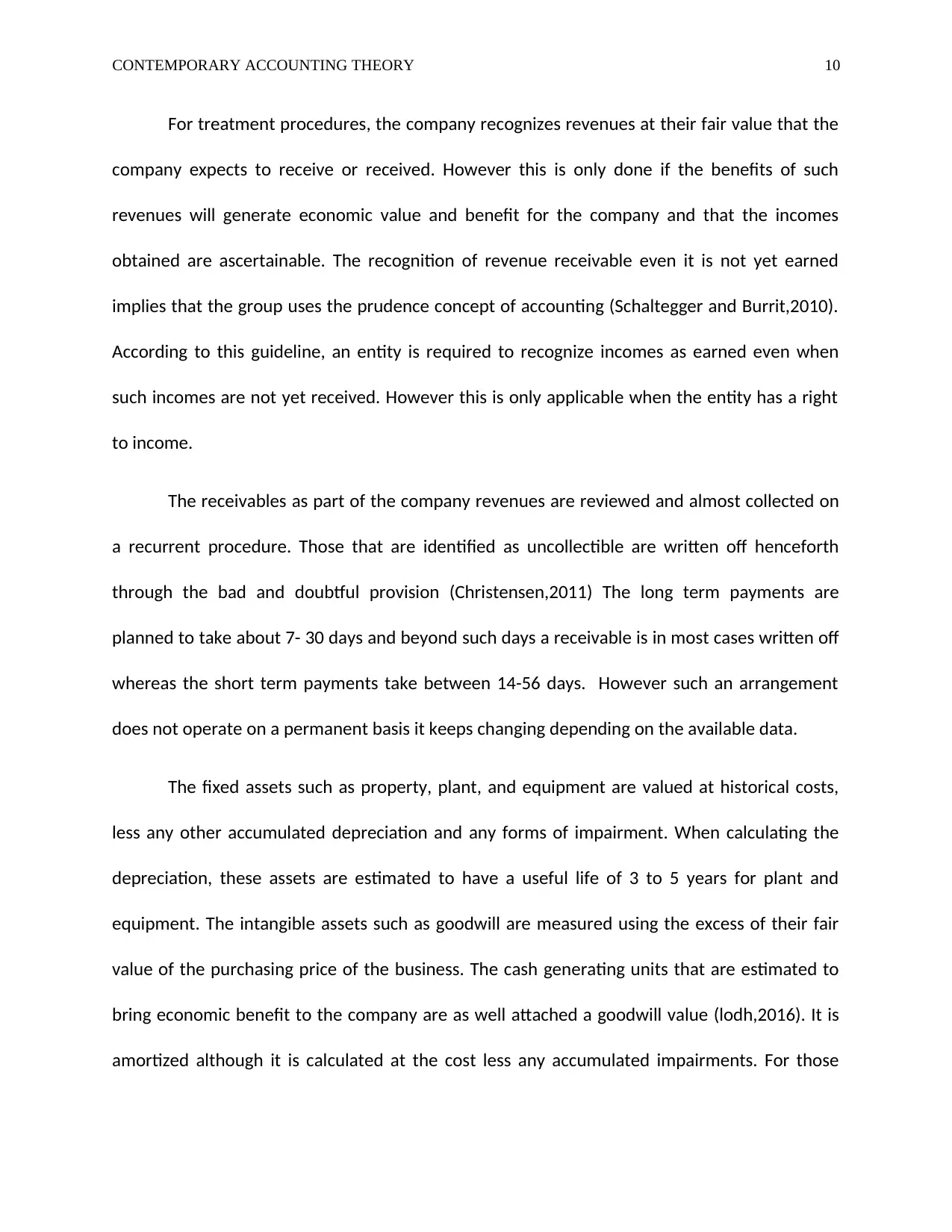
CONTEMPORARY ACCOUNTING THEORY 10
For treatment procedures, the company recognizes revenues at their fair value that the
company expects to receive or received. However this is only done if the benefits of such
revenues will generate economic value and benefit for the company and that the incomes
obtained are ascertainable. The recognition of revenue receivable even it is not yet earned
implies that the group uses the prudence concept of accounting (Schaltegger and Burrit,2010).
According to this guideline, an entity is required to recognize incomes as earned even when
such incomes are not yet received. However this is only applicable when the entity has a right
to income.
The receivables as part of the company revenues are reviewed and almost collected on
a recurrent procedure. Those that are identified as uncollectible are written off henceforth
through the bad and doubtful provision (Christensen,2011) The long term payments are
planned to take about 7- 30 days and beyond such days a receivable is in most cases written off
whereas the short term payments take between 14-56 days. However such an arrangement
does not operate on a permanent basis it keeps changing depending on the available data.
The fixed assets such as property, plant, and equipment are valued at historical costs,
less any other accumulated depreciation and any forms of impairment. When calculating the
depreciation, these assets are estimated to have a useful life of 3 to 5 years for plant and
equipment. The intangible assets such as goodwill are measured using the excess of their fair
value of the purchasing price of the business. The cash generating units that are estimated to
bring economic benefit to the company are as well attached a goodwill value (lodh,2016). It is
amortized although it is calculated at the cost less any accumulated impairments. For those
For treatment procedures, the company recognizes revenues at their fair value that the
company expects to receive or received. However this is only done if the benefits of such
revenues will generate economic value and benefit for the company and that the incomes
obtained are ascertainable. The recognition of revenue receivable even it is not yet earned
implies that the group uses the prudence concept of accounting (Schaltegger and Burrit,2010).
According to this guideline, an entity is required to recognize incomes as earned even when
such incomes are not yet received. However this is only applicable when the entity has a right
to income.
The receivables as part of the company revenues are reviewed and almost collected on
a recurrent procedure. Those that are identified as uncollectible are written off henceforth
through the bad and doubtful provision (Christensen,2011) The long term payments are
planned to take about 7- 30 days and beyond such days a receivable is in most cases written off
whereas the short term payments take between 14-56 days. However such an arrangement
does not operate on a permanent basis it keeps changing depending on the available data.
The fixed assets such as property, plant, and equipment are valued at historical costs,
less any other accumulated depreciation and any forms of impairment. When calculating the
depreciation, these assets are estimated to have a useful life of 3 to 5 years for plant and
equipment. The intangible assets such as goodwill are measured using the excess of their fair
value of the purchasing price of the business. The cash generating units that are estimated to
bring economic benefit to the company are as well attached a goodwill value (lodh,2016). It is
amortized although it is calculated at the cost less any accumulated impairments. For those
Paraphrase This Document
Need a fresh take? Get an instant paraphrase of this document with our AI Paraphraser
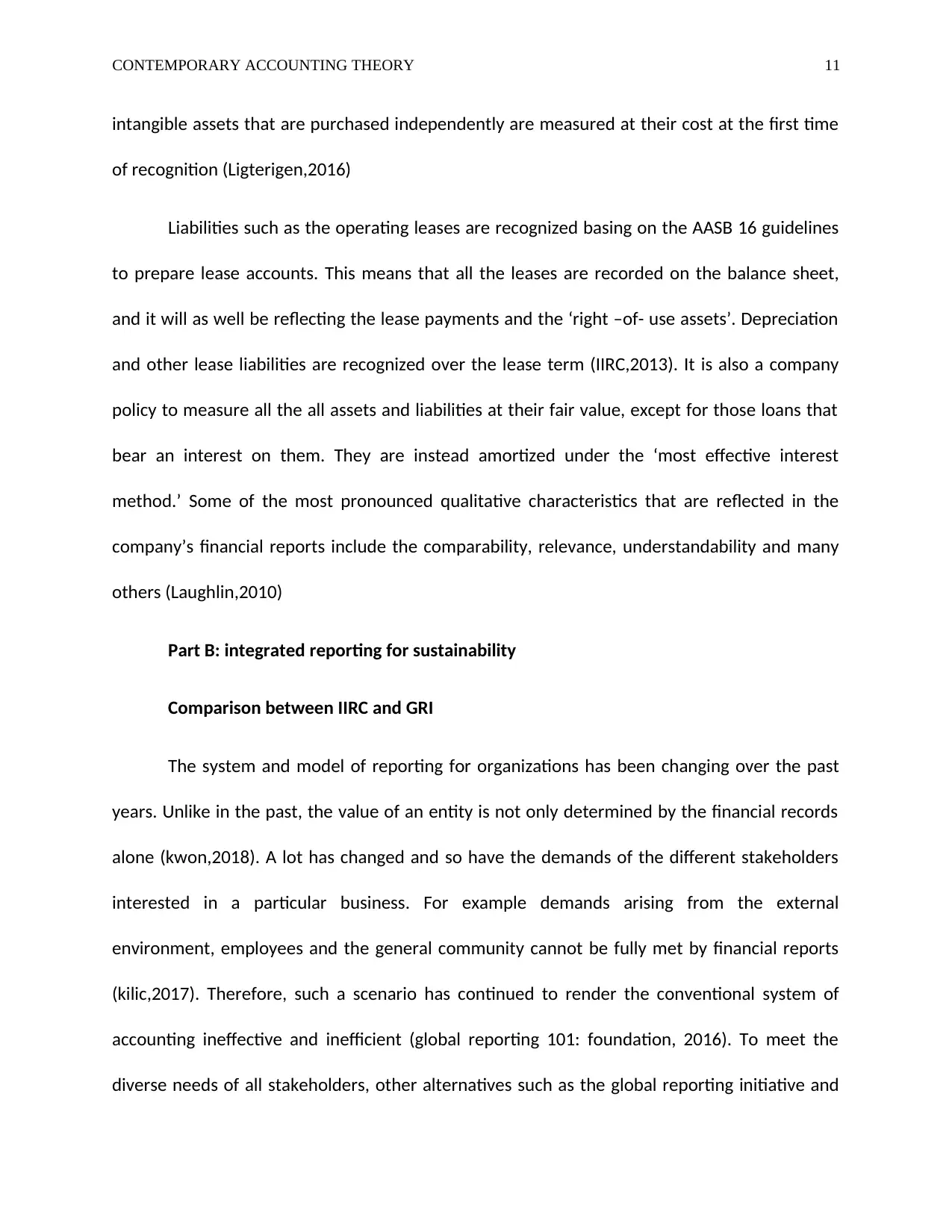
CONTEMPORARY ACCOUNTING THEORY 11
intangible assets that are purchased independently are measured at their cost at the first time
of recognition (Ligterigen,2016)
Liabilities such as the operating leases are recognized basing on the AASB 16 guidelines
to prepare lease accounts. This means that all the leases are recorded on the balance sheet,
and it will as well be reflecting the lease payments and the ‘right –of- use assets’. Depreciation
and other lease liabilities are recognized over the lease term (IIRC,2013). It is also a company
policy to measure all the all assets and liabilities at their fair value, except for those loans that
bear an interest on them. They are instead amortized under the ‘most effective interest
method.’ Some of the most pronounced qualitative characteristics that are reflected in the
company’s financial reports include the comparability, relevance, understandability and many
others (Laughlin,2010)
Part B: integrated reporting for sustainability
Comparison between IIRC and GRI
The system and model of reporting for organizations has been changing over the past
years. Unlike in the past, the value of an entity is not only determined by the financial records
alone (kwon,2018). A lot has changed and so have the demands of the different stakeholders
interested in a particular business. For example demands arising from the external
environment, employees and the general community cannot be fully met by financial reports
(kilic,2017). Therefore, such a scenario has continued to render the conventional system of
accounting ineffective and inefficient (global reporting 101: foundation, 2016). To meet the
diverse needs of all stakeholders, other alternatives such as the global reporting initiative and
intangible assets that are purchased independently are measured at their cost at the first time
of recognition (Ligterigen,2016)
Liabilities such as the operating leases are recognized basing on the AASB 16 guidelines
to prepare lease accounts. This means that all the leases are recorded on the balance sheet,
and it will as well be reflecting the lease payments and the ‘right –of- use assets’. Depreciation
and other lease liabilities are recognized over the lease term (IIRC,2013). It is also a company
policy to measure all the all assets and liabilities at their fair value, except for those loans that
bear an interest on them. They are instead amortized under the ‘most effective interest
method.’ Some of the most pronounced qualitative characteristics that are reflected in the
company’s financial reports include the comparability, relevance, understandability and many
others (Laughlin,2010)
Part B: integrated reporting for sustainability
Comparison between IIRC and GRI
The system and model of reporting for organizations has been changing over the past
years. Unlike in the past, the value of an entity is not only determined by the financial records
alone (kwon,2018). A lot has changed and so have the demands of the different stakeholders
interested in a particular business. For example demands arising from the external
environment, employees and the general community cannot be fully met by financial reports
(kilic,2017). Therefore, such a scenario has continued to render the conventional system of
accounting ineffective and inefficient (global reporting 101: foundation, 2016). To meet the
diverse needs of all stakeholders, other alternatives such as the global reporting initiative and
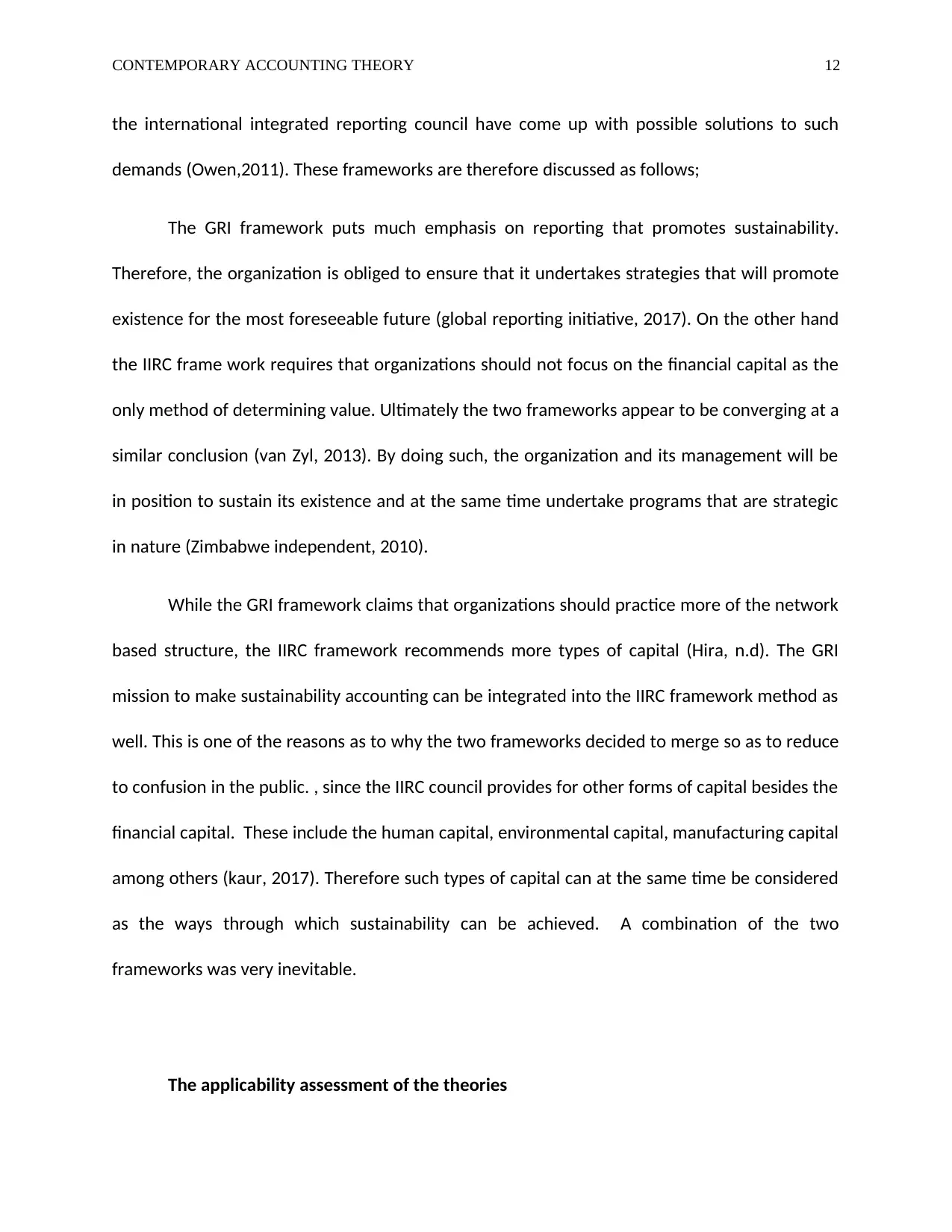
CONTEMPORARY ACCOUNTING THEORY 12
the international integrated reporting council have come up with possible solutions to such
demands (Owen,2011). These frameworks are therefore discussed as follows;
The GRI framework puts much emphasis on reporting that promotes sustainability.
Therefore, the organization is obliged to ensure that it undertakes strategies that will promote
existence for the most foreseeable future (global reporting initiative, 2017). On the other hand
the IIRC frame work requires that organizations should not focus on the financial capital as the
only method of determining value. Ultimately the two frameworks appear to be converging at a
similar conclusion (van Zyl, 2013). By doing such, the organization and its management will be
in position to sustain its existence and at the same time undertake programs that are strategic
in nature (Zimbabwe independent, 2010).
While the GRI framework claims that organizations should practice more of the network
based structure, the IIRC framework recommends more types of capital (Hira, n.d). The GRI
mission to make sustainability accounting can be integrated into the IIRC framework method as
well. This is one of the reasons as to why the two frameworks decided to merge so as to reduce
to confusion in the public. , since the IIRC council provides for other forms of capital besides the
financial capital. These include the human capital, environmental capital, manufacturing capital
among others (kaur, 2017). Therefore such types of capital can at the same time be considered
as the ways through which sustainability can be achieved. A combination of the two
frameworks was very inevitable.
The applicability assessment of the theories
the international integrated reporting council have come up with possible solutions to such
demands (Owen,2011). These frameworks are therefore discussed as follows;
The GRI framework puts much emphasis on reporting that promotes sustainability.
Therefore, the organization is obliged to ensure that it undertakes strategies that will promote
existence for the most foreseeable future (global reporting initiative, 2017). On the other hand
the IIRC frame work requires that organizations should not focus on the financial capital as the
only method of determining value. Ultimately the two frameworks appear to be converging at a
similar conclusion (van Zyl, 2013). By doing such, the organization and its management will be
in position to sustain its existence and at the same time undertake programs that are strategic
in nature (Zimbabwe independent, 2010).
While the GRI framework claims that organizations should practice more of the network
based structure, the IIRC framework recommends more types of capital (Hira, n.d). The GRI
mission to make sustainability accounting can be integrated into the IIRC framework method as
well. This is one of the reasons as to why the two frameworks decided to merge so as to reduce
to confusion in the public. , since the IIRC council provides for other forms of capital besides the
financial capital. These include the human capital, environmental capital, manufacturing capital
among others (kaur, 2017). Therefore such types of capital can at the same time be considered
as the ways through which sustainability can be achieved. A combination of the two
frameworks was very inevitable.
The applicability assessment of the theories
⊘ This is a preview!⊘
Do you want full access?
Subscribe today to unlock all pages.

Trusted by 1+ million students worldwide
1 out of 20
Related Documents
Your All-in-One AI-Powered Toolkit for Academic Success.
+13062052269
info@desklib.com
Available 24*7 on WhatsApp / Email
![[object Object]](/_next/static/media/star-bottom.7253800d.svg)
Unlock your academic potential
Copyright © 2020–2025 A2Z Services. All Rights Reserved. Developed and managed by ZUCOL.




